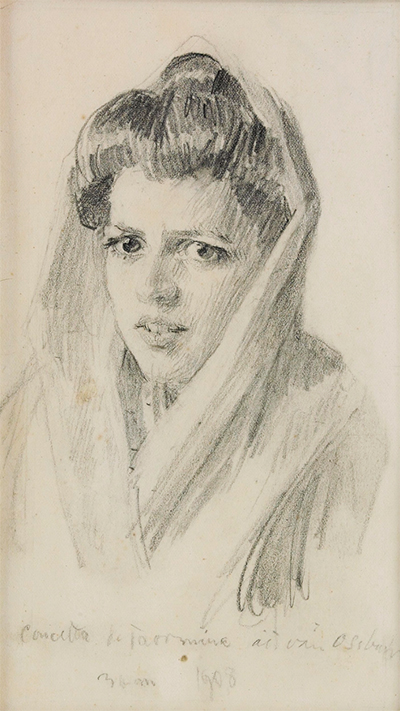Anders Zorn was immediately pinpointed as an artist with exceptional potential and his ability as a draughtsman was a key element of that. As academics start to delve deeper into the artist's oeuvre, his work within mediums such as this are starting to be recognised.
He was an artist who planned his paintings in detail, using pencil or chalk on paper to practice elements of his work as well as to lay out a future composition. He did not want to have to make adjustments in oils later on, and alterations at this stage would be far easier to accomplish. He found portraits to be a very technical genre and something in which precision was particularly important and therefore greater practice and prior planning was needed. He also started to receive portrait commissions from some notable figures, including politicians and royalty, and so an accuracy of depiction was essential to preserving his own reputation. When working previously in the Swedish countryside, perhaps he could have enjoyed a little more freedom within his working practices.
The portrait that we have included within this page is signed and dated, leading us to believe that perhaps it was a quick piece for a friend. In the history of art, drawings have often been gifted to friends and family or, alternatively, passed around studios as a means to educating others. This was particularly the case in the periods of the Renaissance and Baroque movements, where artist studios were at their largest and most productive. They also aimed for a signature style that all apprentices should follow, and hand drawings were sometimes a good way of teaching specific elements of portraiture, but without having to spend too much valuable time on putting it together.
The medium of oil painting has a large amount of overhead involved which can be troublesome when artists are travelling around, particularly in previous centuries when some of our present day comforts were not available. Quick sketches, however, could be made almost anywhere and without any great notice. As someone who travelled extensively, Zorn would have seen these advantages and perhaps kept notepads with him as we moved around from city to city. Another point to remember is that these drawings could provide a reference point later on, sometimes even years later, once the artist had returned to the comfort of his Swedish village. Publications on some of the places that he visited may not have been that helpful to his work, where as these visual diaries would have been far more useful.
When we look over the career of this artist, it is fair to say that his paintings and etchings have been preserved far better than some of his sketches. His drawings are hard to come by, for various reasons. Some have been damaged, some lost, some gifted to others and potentially many also remain lost. It is harder to successfully correct an attribution in this art form than say in painting or etching, and less of a financial reason to do so. Although he did sign some of his drawings, where they were intended to be treated as completed artworks, others were simply study pieces and treated so. This is an issue that applies to most major artist, not just Zorn himself.
Zorn would have received his first structured training as a draughtsman whilst studying at the Royal Swedish Academy of Arts in Stockholm between the years of 1875-1880. This was a long period for any artist to spend at one particular institution and so we can imagine that his studies were both in depth, but also varied in the mediums that he used. Many accounts from other students have taught us about how he made an immediate impact upon arriving here, and it would be wrong to assume that all of it came from his early paintings. In recent years there have been efforts to fully catalogue his etchings, and it is high time the same was done for his work with pencil and chalk.




